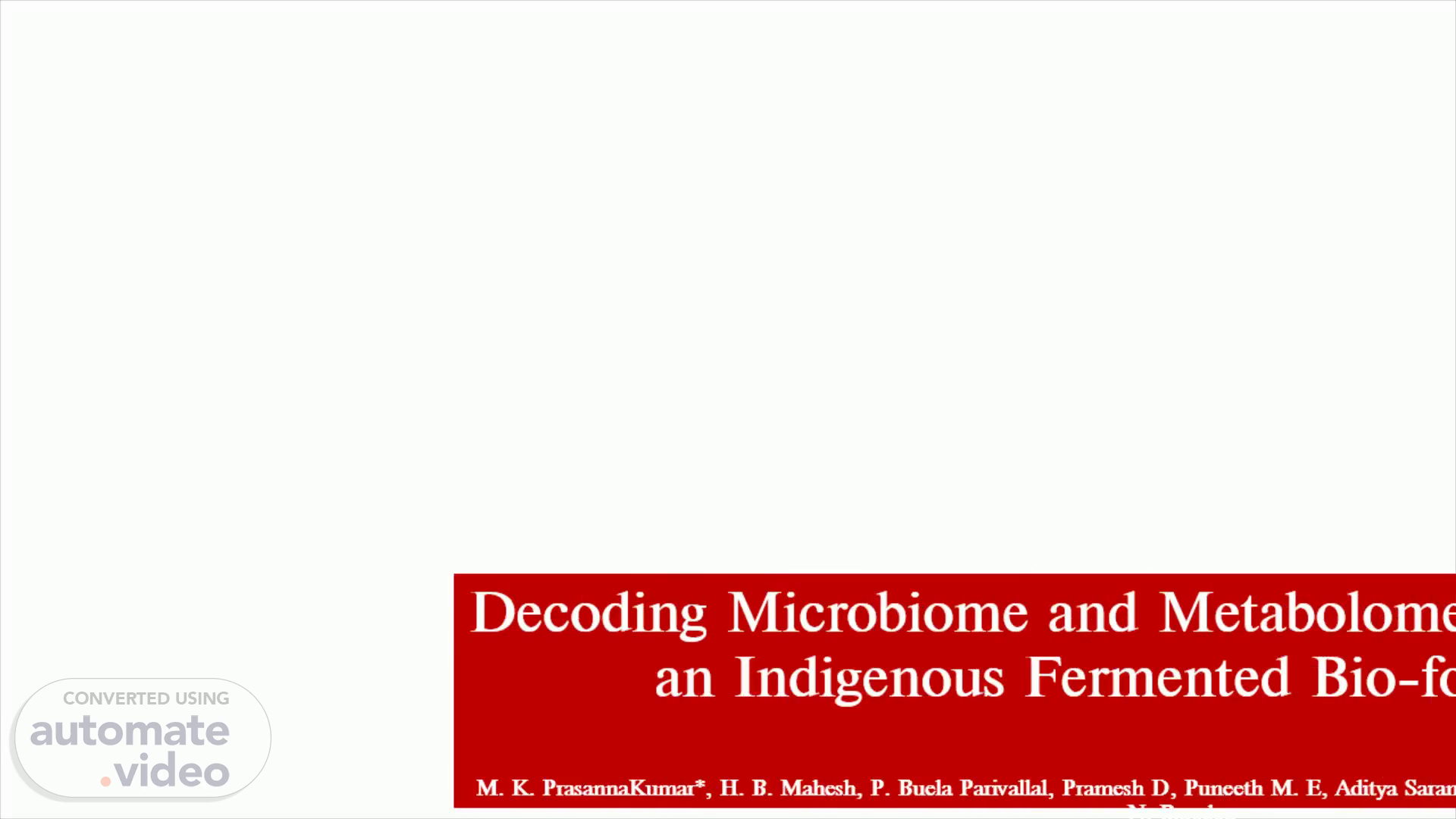
PowerPoint Presentation
Scene 1 (0s)
Decoding Microbiome and Metabolome of Panchagavya - an Indigenous Fermented Bio-formulation M. K. PrasannaKumar *, H. B. Mahesh, P. Buela Parivallal , Pramesh D, Puneeth M. E, Aditya Sarangi, Manasa K. G, Sushil K. Middha , Sahana N. Banakar.
Scene 2 (16s)
Background. Panchagavya is an organic product produced by using five different by-products of cow like cow dung, cow urine, cow milk, cow ghee, cow curd and other ingredients. It has the potential to play the role of promoting growth and providing immunity in plant system thereby confers resistance against pest and diseases. We aimed to report an integrated approach to connect the microbial population assemblages of the Panchagavya by metagenomics and identifying its potential plant-growth-promoting molecules through LCMS attached to the ‘ meltin ’ library..
Scene 3 (40s)
Preparation of Panchagavya. Cow Dung Cow Urine Cow Ghee Cow Curd Cow Milk Ingredients of Panchagavya.
Scene 4 (53s)
OMICS Approach. Panchagavya To understand the fundamental aspect of a complex system Decoding Microbial Community Metabolite Profile METAGENOMICS METABOLOMICS.
Scene 5 (1m 2s)
Metagenomics. Metagenome Sequencing. Metagenome Sequence Analysis.
Scene 6 (1m 36s)
Taxonomic identity and their abundance of different bacteria identified in the Panchagavya bio-formulation..
Scene 7 (1m 45s)
Taxonomic identity and their abundance of different bacteria identified in the Panchagavya bio-formulation. A) Circos containing three halves a. The first halve representing, Micro- organisims classified into 10 groups depending on their potential role b. The second halve representing, genes involved in the amino acid biosynthesis (AAB), amino acid degradation (AAD), amine and polyamine biosynthesis (APAB), amino-sugar metabolism (ASM), Bacterial outer membrane biogenesis (BOMB), cell wall biogenesis (CWB), co-factor biogenesis (CFB), Glycan degradation (GD), Glycan Metabolism (GM) and Metabolic intermediate biosynthesis (MIB) pathways are represented. c. The third halve representing, Genes present in the organism classified for potential role other than pathways. B) Circular diagram indicates the potential role of identified bacteria along with their read depth..
Scene 8 (2m 18s)
Venn-diagram depicting the functional annotation of predicted protein in to major functions. A) Clustered Ortholog Group (COGs) analysis classified the predicted proteins in to three major functional groups. B) Sub-system annotation of the predicted proteins..
Scene 9 (2m 31s)
Microbial community composition of Panchagavya formulation assessment using CCMetagen revealed 18% of the reads are of eukaryotic origin..
Scene 10 (2m 41s)
Metabolomics. Extraction of metabolites for LC-MS/MS analysis LC-MS/MS analysis Metabolome data analysis Multi-solvent and Aqueous QTRAP 6500 mass spectrometer Agilent 1290 Infinity II LC system XCMS online tool Metlin ’ metabolite database.
Scene 11 (2m 54s)
Medium Total Features Features identified in METLIN Positive Negative Positive Negative Aqueous extract 2035 946 1086 448 Multi solvent extract 1783 973 985 451 Total 5737 2970.
Scene 12 (3m 8s)
Compound Function Category Gibberellic Acid (GA) GA is responsible for plant development processes, more specifically the stem growth. Plant hormone Gibberellin A70 A70 is a mutant of GA, it assimilates less carbon per unit of plant mass per day leading to reduce shoot growth Plant hormone Gibberellin A45 Derivative of GA, present in immature seeds Plant hormone Gibberellin A61 Derivative of GA, present in immature seeds involved in early hydroxylation pathway Plant hormone Gibberellin A51 Derivative of GA, present in immature seeds involved in early hydroxylation pathway Plant hormone Gibberellin A4 Derivative of GA, stimulates greater vegetative elongation. It is more effective for induction of staminate flowers Plant hormone Gibberellin A20 Derivative of GA, promotes shoot elongation Plant hormone Gibberellin A29-catabolite Catabolite of GA, forms during the final stage of seed maturation Plant hormone Gibberellin A14 aldehyde Derivative of GA Kaurenol Derivative of Kaurene, involved in seedling growth (phytochrome mediated) Growth factor Strigol Strigol, terpenoid lactone secreted by roots of mono and dicotyledonous plants has been reported to possess germination stimulant activity for seeds Growth factor Spinosin A Spinosin A, major flavonoid compound in Zizyphi semen, responsible for spore germination Insecticide Quercetin 3-rutinoside Rutin,a phytochemical having a quercetin aglycon portion and rutinose, chemically is named quercetin rutinoside, it’s a flavonoid with antioxidant activity found in medicinal plants Flavonoid Brassinin Brassinin is an essential indole phytoalexin produced in plants of the family 69 Brassicaceae Phytoalexin Brassicasterol Brassicasterol, a plant sterol responsible for plant growth promotion Growth factor cis-Zeatin 9-glucoside Cis-isoprenoid is a cytokinins stimulates the plant growth Plant hormone Indole Acetic Acid An auxin involved in growth promotion Plant hormone.
Scene 13 (4m 15s)
Applications. Improves soil fertility Maintaining good soil health Production of invariably bigger leaves and denser canopy Enhances photosynthetic material Production of synthetic pesticide-free food.
Scene 14 (4m 26s)
Summary. Updated molecular techniques were used to validate and elucidate the effect of Panchagavya. Metagenomics approach was used to decipher the bacterial microbiome structure, which showed promising results for their existence and abundance in Panchagavya. The metabolome predicted the byproducts of numerous plant growth promoters as well as other compounds released and fermented by these bacteria. Panchagavya is a promising manure that contains helpful microorganisms and plant development promoters . Panchagavya is a bio-formulation that is both ecologically benign and effective in improving soil and crop health ..